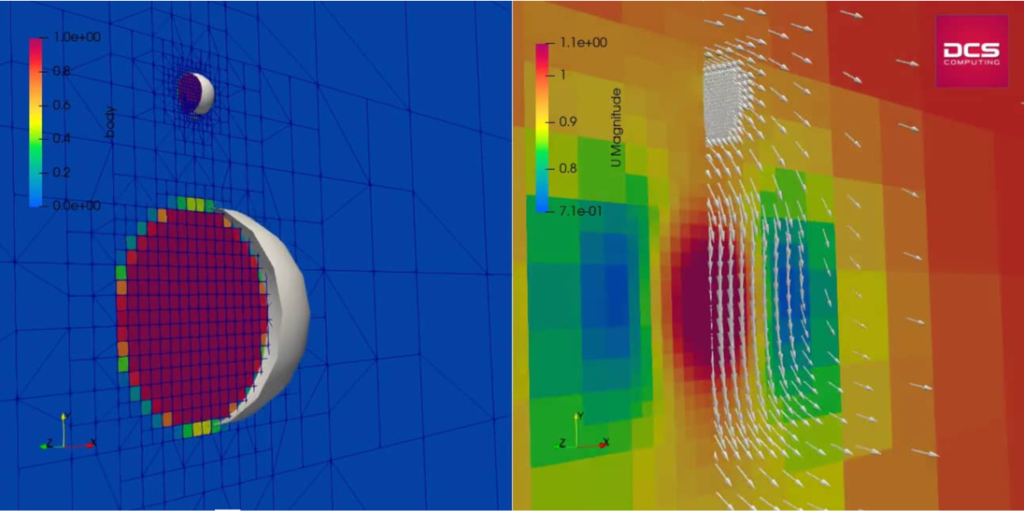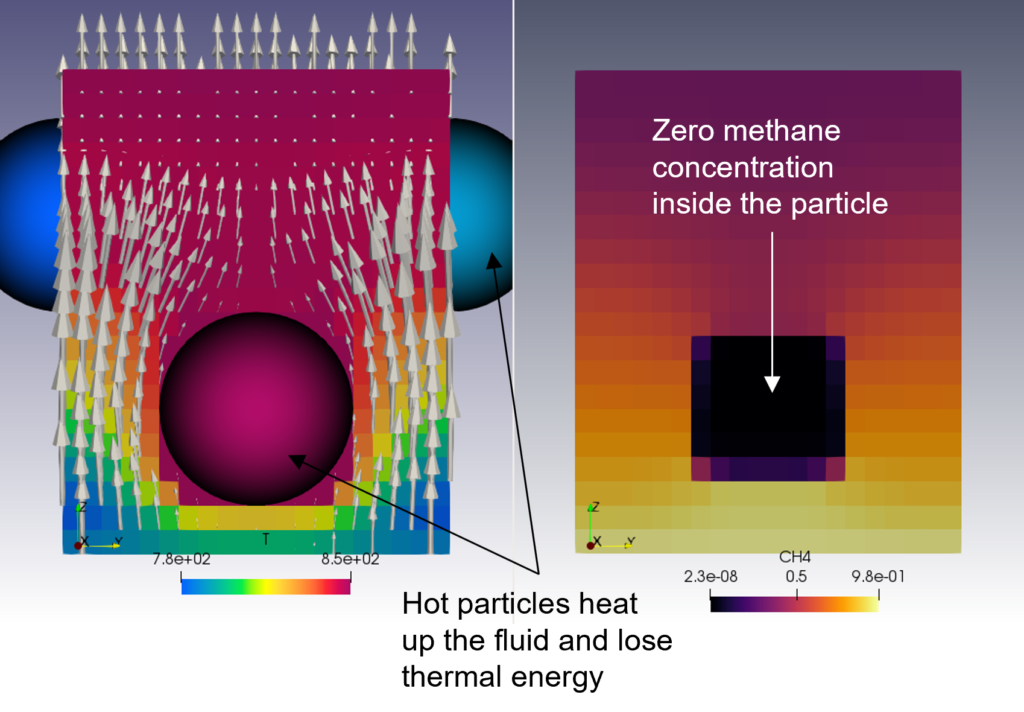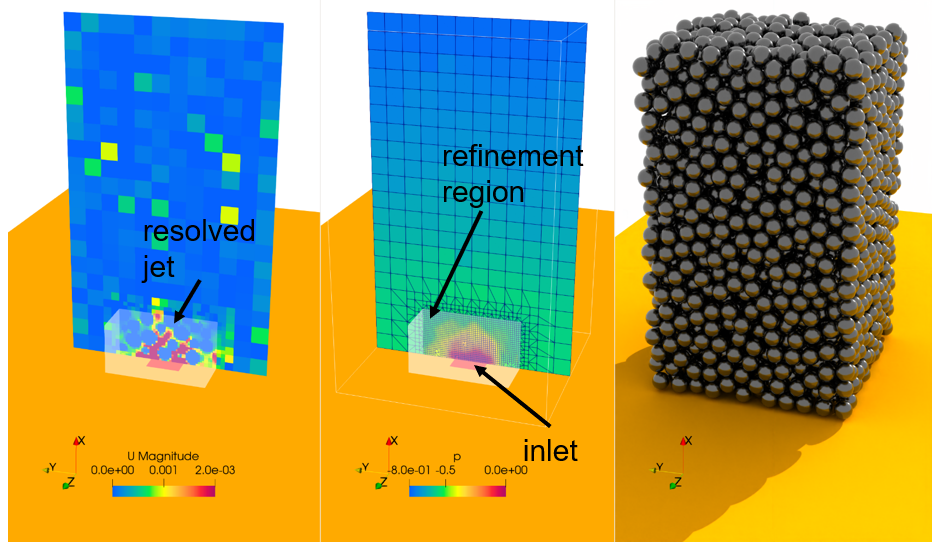In the Immersed Boundary Method particles are resolved within the fluid field for getting an accurate representation of the flow around and between the particles. This method requires fine grids and is particularly suitable for cases with relatively low numbers of particles. A hybrid resolved and unresolved approach allows to consider parts of the simulation domain in detail while not restricting the overall proplem size in general. IB approaches can also be used for an efficient geometry representation in coupled simulations.

Mesh refinement is carried out for IBM particles – depending on their size. The mesh is refined until a given number of cells per particle is reached.

CFDEM®coupling can use Immersed Boundary Method (IBM) to calculate the conductive heat flux between a rigid body and the surrounding fluid.
The heat transfer is enabled by the force model LaEuScalarTempIB (on the coupling side) and by the Aspherix® command enable_heat_conduction (on the DEM side).
Additional feature of LaEuScalarTempIB: prescribe a mass diffusivity inside the immersed bodies to control the transport of chemical species inside/outside the body.

A dedicated mesh motion model (IBSphere) allows to “combine” resolved particles (using Immersed Boundary Method) with “unresolved” CFD-DEM. This enables an easy setup of IB cases with mesh interfaces and complex physics.

By loading the video, you agree to Vimeo's privacy policy.
Learn more
Coupled CFD-DEM simulation of particles in a complex, time-varying geometry. For this purpose, an Immersed Boundary Method (IBM) solver has been coupled with Aspherix®. The IBM, in contract to traditional finite volume method, allows to solve the flow in interlocking geometries.

By loading the video, you agree to Vimeo's privacy policy.
Learn more
Deposition of fine particles and the build-up of significant volume is typically a very slow process. This temporal constraint as well as the huge number of particles makes the simulation of powder deposition very challenging. By combining Immersed Boundary Method for deposited material and unresolved CFD-DEM, it is possible to model e.g. clogging of a channel with dust in an efficient manner.

By loading the video, you agree to Vimeo's privacy policy.
Learn more
The basic concept of hybrid resolved-unresolved IB is the following: within a simulation, some particles are treated as resolved while others are considered unresolved. The selection of the handling is done by a geometric region (i.e., if a particle is in the region, do IB). Automatic refinement is used to achieve the resolved resolution for the refined particles.

The animation shows a fully coupled CFD-DEM model of a spoon stirring a teacup with a piece of sugar inside. The liquid and the dissolution of the sugar is modeled by Finite Volume CFD approach, the moving spoon is modeled by Immersed Boundary Method in CFD and moving mesh in DEM. The sugar cube consists of spheres connected by bonds. The mass of the dissolving sugar cube in DEM is tracked in the CFD using a scalar transport equation.

By loading the video, you agree to Vimeo's privacy policy.
Learn more

By loading the video, you agree to Vimeo's privacy policy.
Learn more
Mesh refinement is carried out for IBM particles – depending on their size. The mesh is refined until a given number of cells per particle is reached.

CFDEM®coupling can use Immersed Boundary Method (IBM) to calculate the conductive heat flux between a rigid body and the surrounding fluid.
The heat transfer is enabled by the force model LaEuScalarTempIB (on the coupling side) and by the Aspherix® command enable_heat_conduction (on the DEM side).
Additional feature of LaEuScalarTempIB: prescribe a mass diffusivity inside the immersed bodies to control the transport of chemical species inside/outside the body.

A dedicated mesh motion model (IBSphere) allows to “combine” resolved particles (using Immersed Boundary Method) with “unresolved” CFD-DEM. This enables an easy setup of IB cases with mesh interfaces and complex physics.

By loading the video, you agree to Vimeo's privacy policy.
Learn more
Coupled CFD-DEM simulation of particles in a complex, time-varying geometry. For this purpose, an Immersed Boundary Method (IBM) solver has been coupled with Aspherix®. The IBM, in contract to traditional finite volume method, allows to solve the flow in interlocking geometries.

By loading the video, you agree to Vimeo's privacy policy.
Learn more
Deposition of fine particles and the build-up of significant volume is typically a very slow process. This temporal constraint as well as the huge number of particles makes the simulation of powder deposition very challenging. By combining Immersed Boundary Method for deposited material and unresolved CFD-DEM, it is possible to model e.g. clogging of a channel with dust in an efficient manner.

By loading the video, you agree to Vimeo's privacy policy.
Learn more
The basic concept of hybrid resolved-unresolved IB is the following: within a simulation, some particles are treated as resolved while others are considered unresolved. The selection of the handling is done by a geometric region (i.e., if a particle is in the region, do IB). Automatic refinement is used to achieve the resolved resolution for the refined particles.

The animation shows a fully coupled CFD-DEM model of a spoon stirring a teacup with a piece of sugar inside. The liquid and the dissolution of the sugar is modeled by Finite Volume CFD approach, the moving spoon is modeled by Immersed Boundary Method in CFD and moving mesh in DEM. The sugar cube consists of spheres connected by bonds. The mass of the dissolving sugar cube in DEM is tracked in the CFD using a scalar transport equation.

By loading the video, you agree to Vimeo's privacy policy.
Learn more

By loading the video, you agree to Vimeo's privacy policy.
Learn more